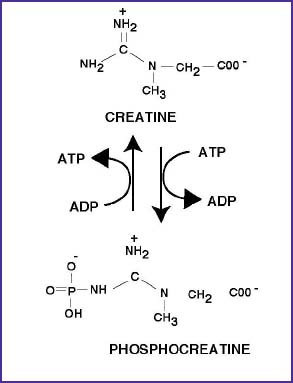When
our muscles use ATP for energy a chemical process happens where the ATP is broken
down into two simpler chemicals ADP (adenosine di-phosphate) and inorganic phosphate.
This process of ATP turning into ADP releases the energy which gives our muscles
the ability to contract. Unfortunately, there is not an endless supply of ATP.
In fact, our muscles only contain enough ATP to last about 10-15 seconds at
maximum exertion (see Part 2). The ADP can not be used to create more energy
for our muscles and so here is where the creatine comes in - or more specifically
the creatine phosphate (CP). The majority of creatine that is stored in the
muscles bonds with abundant phosphorus stores in the muscles and is converted
into Creatine Phosphate (CP). CP is able to react with the ADP in the body and
turn "useless" ADP back into the energy source - ATP. More ATP in the body means
more fuel for our muscles.
